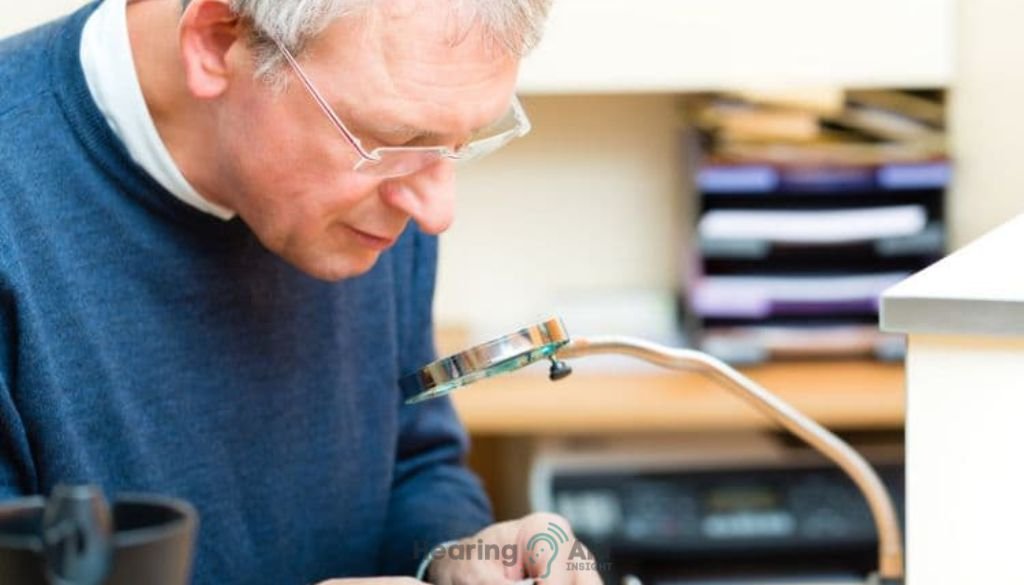Dealing with malfunctioning or damaged hearing aids can cause concern for many users. If you ask yourself, “Can hearing aids be repaired?” the reassuring answer is yes. Most hearing aids can be repaired, often restoring them to full functionality. Improving a hearing aid varies depending on the type and extent of damage, ranging from simple in-office adjustments to more complex repairs that might require sending them back to the manufacturer.

Whether it’s issues related to sound quality, physical damage, or battery problems, professional hearing aid technicians possess the necessary skills and tools to diagnose and rectify these issues. They can handle various situations, from minor fixes like replacing a battery door or repairing tubing to addressing more severe concerns like internal component damage. Understanding the repair process, potential costs, and turnaround times can help you navigate the situation more efficiently.
Key Takeaways:
- Hearing aids can be repaired when they experience wear and tear or damage.
- Onsite technicians specialize in hearing aid repair and can fix common issues such as drops or strikes, water damage, and wax or dust build-up.
- Prescribed hearing aids are essential for quick and effective repairs.
- Regular maintenance and cleaning routines are necessary for keeping hearing aids in good working condition.
- Seeking professional help is recommended for optimal performance and to enjoy the benefits of better hearing.
Understanding Common Hearing Aid Issues
Hearing aids are delicate devices that can encounter various issues over time. By understanding common problems, you can better protect and maintain your investment in better hearing. Here, we’ll explore three common issues hearing aid users may encounter: drops or strikes, water damage, and wax or dust build-up.
Drops or Strikes
Hearing aids are susceptible to damage from accidental drops or strikes. To minimize the risk, avoid storing your hearing aids in the bathroom or other areas prone to accidents. Take extra care when handling them, and consider using a protective case when not in use. If your hearing aids sustain damage from a drop or strike, it’s essential to have them inspected and repaired by a professional technician.
Water Damage
Water damage is a common issue for hearing aids. While some models are water-resistant, none are entirely waterproof. It’s essential to avoid submerging your hearing aids in water or exposing them to excessive moisture. If your hearing aids get wet, promptly remove and dry the batteries using a gentle, quick-drying technique. Seeking professional assistance for water-damaged hearing aids is crucial to prevent further damage or malfunction.
Wax or Dust Build-Up
Regular cleaning routines prevent wax or dust build-up in your hearing aids. Earwax and debris can accumulate in the openings and vents, affecting sound quality and performance. Your audiologist can guide you on proper cleaning techniques and recommend specialized tools for maintenance. By keeping your hearing aids clean and free from obstructions, you can reduce the need for repairs and ensure optimal functionality.
In the next section, we will explore how Beltone, a leading provider of hearing aids, can assist with hearing aid repairs.
How Beltone Helps with Hearing Aid Repairs
Beltone understands the importance of efficient and reliable hearing aid repairs. That’s why they have dedicated onsite technicians trained to diagnose and fix various issues quickly. With their extensive knowledge and expertise, they can provide prompt and effective repairs to ensure that your hearing aids are back to optimal performance in no time.
One key advantage of Beltone is its strong relationship with hearing aid manufacturers. This lets them stay updated with the latest technology and repair techniques, ensuring they can provide the best service possible. By working closely with the manufacturers, Beltone technicians have access to specialized training and resources, allowing them to address even the most complex repair needs.
In cases where repairs are beyond the capabilities of the onsite technicians, Beltone can facilitate direct communication with the hearing aid manufacturer. This ensures that critical components can be replaced to restore your hearing aids to full functionality. However, it’s important to note that replacement is considered only after all repair options have been exhausted, as Beltone is committed to providing cost-effective solutions whenever possible.
Read Also: Do hearing aids prevent further hearing loss?
Benefits of Beltone’s Repair Services:
- Quick and efficient repairs by trained onsite technicians
- Strong relationship with hearing aid manufacturers for access to the latest technology
- Facilitation of critical component replacement through direct communication with the manufacturer
- Cost-effective solutions are prioritized to extend the lifespan of your hearing aids.
You can trust Beltone to provide the expertise and support you need regarding hearing aid repairs. Their commitment to exceptional service ensures you can continue enjoying the benefits of better hearing for years.
Types of Hearing Aid Damage and Repairs
Hearing aids can be prone to various types of damage affecting their functionality. Understanding these types of damage and the available repairs can help you address issues promptly and ensure optimal performance. Here are some common types of hearing aid damage and the corresponding maintenance:
1. Moisture Damage
Moisture can be one of the biggest culprits regarding hearing aid damage. Water, sweat, and humidity exposure can lead to corrosion and circuitry problems. If your hearing aids have been exposed to moisture, it’s essential to seek professional help to remove it and repair any damage. Regular inspections and cleaning routines can also help prevent moisture-related issues.
2. Broken Tubing
Some hearing aids, particularly behind-the-ear (BTE) styles, have tubing that connects the device to the earpiece. Over time, this tubing can degrade, crack, or get clogged with debris, affecting sound transmission. If you notice a decreased sound quality or suspect broken tubing, it’s best to consult an audiologist. They can easily replace the tubing and ensure optimal performance.
3. Damaged Microphone
The microphone is a crucial component of hearing aids that picks up sounds and converts them into electrical signals. However, the microphone can sometimes get damaged due to accidents, drops, or other impacts. Suppose you experience issues with sound quality or find that your hearing aids are not picking up sounds correctly. In that case, it’s essential to have the microphone checked and repaired by a professional.
By understanding the types of damage that hearing aids can experience and the corresponding repairs, you can take proactive steps to prevent and address issues effectively. Regular maintenance, including inspections and cleaning routines, is critical to maintaining the longevity and optimal performance of your hearing aids.
Read Also: Can Ear Drops Damage Hearing Aids?
Importance of Regular Maintenance
Regular maintenance is crucial for keeping your hearing aids in optimal working condition. By implementing a cleaning routine and following some simple steps, you can ensure that your devices function at their best, allowing you to enjoy sound to the fullest.
One of the common issues that can affect the performance of hearing aids is the build-up of earwax. Earwax can clog the sound vents and microphone, reducing the quality and clarity of the sound. Therefore, it is essential to clean your hearing aids regularly to remove any accumulated wax. You can use specialized tools or a dry cloth to gently clean your devices’ external surfaces.
“Regular maintenance can help prevent issues caused by earwax build-up and other common problems, ensuring that you get the most out of your hearing aids.”
In addition to cleaning, routine inspections by professionals are recommended. Even with regular cleaning efforts, moisture can still find its way into the hearing aids, especially after exposure to humidity or rain. A professional inspection can help detect any signs of moisture damage and address any potential issues before they become significant problems.
Regular Maintenance Tips:
- Clean your hearing aids regularly to remove earwax and debris.
- Use specialized tools or a dry cloth for cleaning.
- Keep your hearing aids away from moisture and store them dry.
- Consider investing in a hearing aid dehumidifier to remove water.
- Have your hearing aids inspected by professionals at least once a year?
By following these regular maintenance practices, you can prolong the lifespan of your hearing aids and ensure that they continue to perform optimally. Remember, taking care of your hearing aids is essential for maintaining good hearing health and maximizing your overall quality of life.
Knowing When to Seek Hearing Aid Repairs
Routine professional inspections are crucial for identifying potential issues with your hearing aids. These inspections help ensure that your devices function optimally and that any necessary repairs can be promptly addressed. By seeking routine inspections, you can prevent minor problems from escalating into major ones, saving you time and money in the long run.
If you have been exposed to high humidity or have been caught in a significant rainstorm, it is essential to have your hearing aids checked. Moisture can seep into the delicate components of the devices, leading to malfunctioning or damage. By seeking professional evaluation after such exposure, you can catch any moisture-related issues early and prevent further damage.
Paying attention to any gradual changes in your hearing is also essential. Over time, our hearing can naturally adjust to compensate for changes in our auditory abilities. This can make it difficult to notice when our hearing aids are no longer performing optimally. Routine inspections by professionals can help identify any gradual problems and make the necessary adjustments or repairs to ensure you continue to enjoy the benefits of better hearing.
Conclusion
Hearing aid repairs are crucial to maintaining optimal sound quality and extending the lifespan of these valuable devices. Whether your hearing aids have experienced wear and tear or damage, various repair options are available to restore their functionality.
Thanks to the expertise of onsite technicians, many repairs can be done quickly and cost-effectively. From addressing drops or strikes to tackling water damage and removing wax or dust build-up, these skilled professionals have the knowledge and tools to get your hearing aids back in working order.
To fully enjoy the benefits of better hearing, regular maintenance is essential. Implementing a cleaning routine and scheduling routine inspections by professionals can help prevent problems and identify issues early on. By taking proactive measures, you can keep your hearing aids in good working condition and ensure you’re experiencing sound to the fullest.
Can white noise cause tinnitus? In our detailed article, we explore various aspects and provide valuable insights.
Frequently Asked Questions
Can hearing aids be repaired?
Hearing aids can be repaired when they experience wear and tear or damage.
What are common issues with hearing aids?
Common issues with hearing aids include drops or strikes, water damage, and wax or dust build-up.
How does Beltone help with hearing aid repairs?
Beltone has onsite technicians who can quickly repair hearing aids. They also have a strong relationship with the hearing aid manufacturer to provide efficient service.
What types of damage can hearing aids experience?
Hearing aids can experience moisture damage, broken tubing, and damaged microphones.
Why is regular maintenance necessary for hearing aids?
Regular maintenance, including cleaning routines, is essential for keeping hearing aids in good working condition and preventing issues like earwax build-up.
When should I seek professional help for my hearing aids?
It is recommended to seek a professional evaluation if you suspect something is wrong with your hearing aids or after exposure to humidity or a significant rainstorm.
What are the available options for hearing aid repairs?
Hearing aid repairs depend on the nature of the damage but can often be done quickly and cost-effectively to restore functionality and extend the device’s lifespan.



